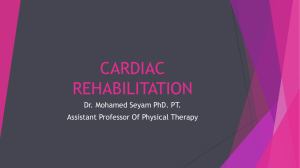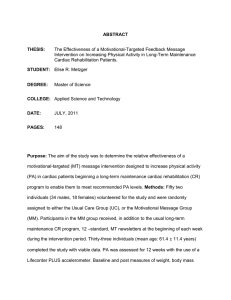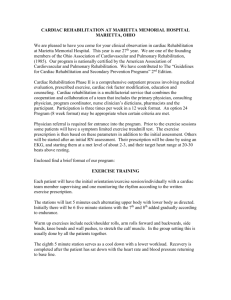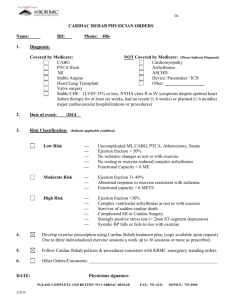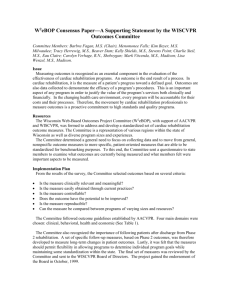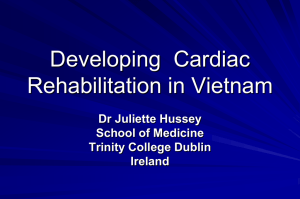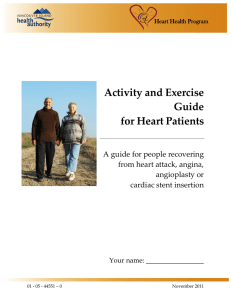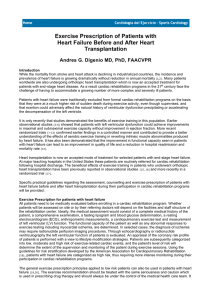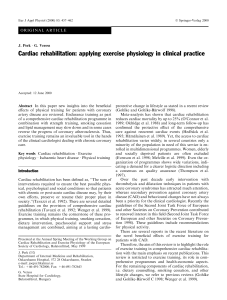cvs 6th lecture
advertisement
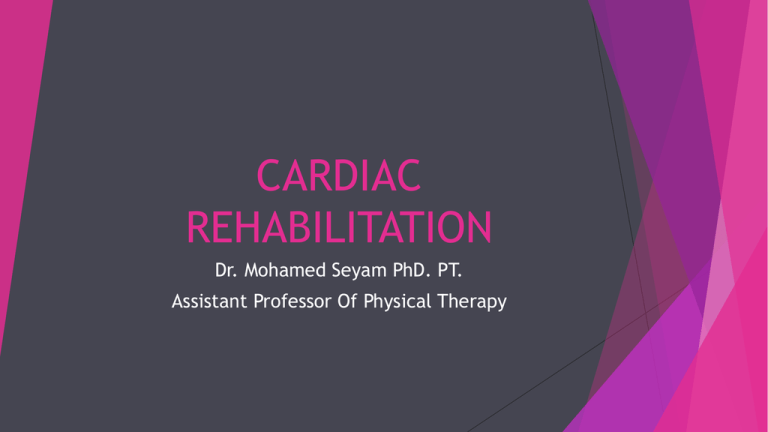
CARDIAC REHABILITATION Dr. Mohamed Seyam PhD. PT. Assistant Professor Of Physical Therapy OBJECTIVE Define different phases during implementation of exercise program in cardiac rehabilitation. Demonstrate exercise prescription in each phase. PHASES OF CARDIAC REHABILITATION PHASE I hospital activity PHASE II immediate post discharge PHASE III supervised out patients exercise program PHASE IV transition to long term community ex’s PHASE I Graduated mobilization is initiated in the first 24-48 hours post cardiac event The patient is allowed to perform his morning care and to feed himself Start to participate in exercise program initially, supine, sitting and standing Monitoring patient heart rates, blood pressure, resting electrocardiographic(ECG) and heart and breath sounds may also be auscultated in selected patients PHASE II May last from 2 to 6 weeks. It involves a closely supervised and carefully monitored exercise Exercise prescription should be individualized and based on medical history, physical examination and recent exercise stress testing results Three main components of an exercise training program Frequency: minimum frequency for exercising is 3 times weekly Time: usually need 30 -60 minutes for each session Intensity: from 13-15 RPE in the Borg scale PHASE III Last up to 6-12weeks. Required minimum equipment monitoring. Competitive environments. Aerobic, strengthening and endurance training. Frequency :1-2 times per week at supervised rehabilitation, Twice weekly independent home exercise, The remaining days Walking. Timing: increase time to 20-30 minutes Intensity: THR PHASE IV Medically and psychologically stable Improvement functional capacity ( 5 METs) Exercise safe, effective and individual. Lifestyle changes and risk factor modification Monitor his own HR or use RPE Recognize warning signs and symptoms Mission of Cardiac Rehab To restore and maintain an individual’s optimal physiological, psychological, social and vocational status. Goals of Cardiac Rehab Identify, modify, and manage risk factors to reduce disability/morbidity and mortality Improve functional capacity Alleviate/lessen activity related symptoms Educate patients about the management of heart disease Improve quality of life Core Program Components Risk factor management Baseline and ongoing patient assessment Exercise/activity training What is Cardiac Rehabilitation? Medically Lifestyle supervised modification Monitored progressive exercise/activity Inpatient-Outpatient-Maintenance (Phase I, II, III) Individualized, typically 3x/week, up to 12 weeks Physician Referral Required Patient Benefits: Improved functional capacity Increased knowledge of heart disease Improved adherence to positive lifestyle changes Better compliance with medical regime Increased self-esteem and confidence Reduced subsequent morbidity and mortality r/t CAD Risk Factors Tobacco Smoking 50% and Chew decreased risk of CHD 1 year after cessation Hypertension 90% 35 middle-aged Americans will develop HTN million office visits/yr for HTN Risk Factors Hyperlipidemia 105,000,000 10% reduction in TC = 30% reduction in incidence of CAD Physical $76 > people with a tot chol > 200 Inactivity billion 60% of Americans don’t get sufficient exercise Risk Factors Obesity More than 50% women and 60% men are overweight or obese Nearly 300,000 American adults die of causes related to obesity Diabetes 58% reduction by lifestyle intervention 75% of people w/DM die of CAD or vascular disease Cardiac Rehab Professionals Partners in Patient Care: Medical Director Referring Physician Registered Nurses Physiotherapist Exercise Physiologists Dieticians/Nutritionists Social Services/Psychosocial Pharmacists
